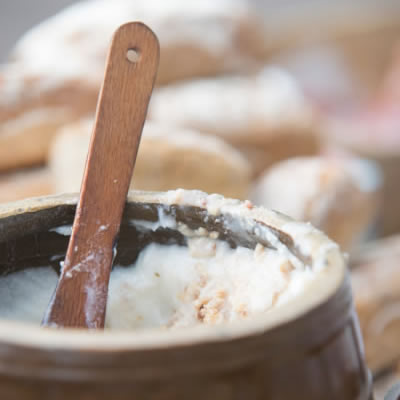
Lard
Also known as pork fat
What is Lard?
Lard is a white, soft fat obtained from pigs. It has a distinctive flavor and unique crystal structure which enhances flakiness in pie crusts. Its high smoke point makes it popular for frying and cooking applications.1
Similar to other fats, lard is a triglyceride with various fatty acids make-up depending on the diet of the hog. It is commercially available in several forms, mainly:
- Rendered (extracted or melted)
- Unrendered
Origin
Lard has been cooked with since prehistoric times.2 It is a staple fat in British, Latin and Asian cuisine. The 1970s witnessed a decline in lard usage in baking and frying in the United States due to increased health concerns about saturated fats and heart disease. Also, due to religious dietary restrictions such as Halal and Kashrut. Today, it is still popular in British, Central European, Chinese and Mexican cuisines.1
There are three main sources of lard:
- Leaf lard: obtained from the fat deposits surrounding the pig’s kidneys. It is the highest quality lard with a melting range of 30-40 °C (86-104 °F).
- Back fat lard: obtained from the back skin and flesh and has a melting range of 43-48 °C (109-118 °F).
- Caul lard: the lowest quality lard obtained from the surroundings of the digestive system, in particular the small intestine. It’s melting range is 36-45 °C (97-113 °F).
Function4
Lard serves several functions in baking such as:
- Flavor: provides a mild pork-like flavor to baked goods.
- Flakiness: gives a crumbly flaky texture to pie crust due to lard’s unique large and stable fat crystals.
- Tenderizer: mainly via coating proteins from gluten and eggs or starch granules. Thus, providing a higher degree of tenderization than butter.
- Leavening: incorporates air into the dough during the creaming process.
- Staling: prevents staling by retarding starch gelatinization due to starch coating.
- Color: allows a faster browning due to the increase of heat rate associated with fats.
Nutrition
Composition of lard (per 100 gram):
| Component | Grams |
| Saturated Fats | 39 |
| Monounsaturated Fat | 45 |
| Polyunsaturated Fat | 11 |
| Cholesterol | 0.95 |
As a high saturated fat, consumption of this food has been associated with high blood pressure and coronary heart disease. However, it has less saturated fat than the same amount of butter by weight.1,3
Commercial production1
Rendered fat can be obtained through two processes:
- Wet rendering: the lard is boiled in water until the fat floats to the top followed by undesirable residues. The obtained product is flavor-neutral and translucent, with a high smoke point.
- Dry rendering: the lard is heated in a vacuum sealed autoclave and impurities are further removed. The obtained product has lower smoke point, distinct flavor, and a slightly brown color.
After rendering it can go through other refining processes, such as:
- Bleaching
- Deodorization
- Emulsifying
- Hydrogenation
- Addition of antioxidants
Application
Lard use has decreased through the ages and has been substituted by vegetable shortening. However, many cooking and baking non-commercial applications still call for lard usage due to its unique flavor and crystal structure such as:
- Yeast dough additions
- Pie pastry
- Pan greasing
Some considerations when baking with lard:
- Its low degree of creaming in comparison with butter. So, it is not recommended for cake batters, cookies or biscuits.5
- Provides the best pie crust from all solids fats due to the high amount of fat present and its plasticity.4,5
FDA regulations
Lard is considered by the FDA as a Partially Hydrogenated Oil (PHO’s) for the analysis of its status as a Generally Recognized As Safe (GRAS) food product. Since 2015, PHO’s are no longer recognized as safe by the FDA, and can’t be used as ingredients in food products.6
References
- Marcus, J B. Culinary Nutrition:The Science And Practice Of Healthy Cooking. 1st ed., Elsevier/Academic Press, 2013, pp. 256-258.
- Bockisch, Ml, ed. Fats and oils handbook (Nahrungsfette und Öle). 1st ed., Elsevier, 2015, p. 2.
- Chow, C. K. Fatty acids in foods and their health implications. 2 nd ed., CRC press, 2007, pp 391-392.
- Figoni, P. How Baking Works: Exploring The Fundamentals Of Baking Science. 2nd ed., John Wiley & Sons, Inc., 2008, pp. 209-223.
- The BC Cook Articulation Committee. “Understanding Ingredients For The Canadian Baker.” 1 st ed., Bccampus, 2015, p.65 . Available at https://opentextbc.ca/ingredients/ .
- U.S. Department of Health and Human Services and U.S. Department of Agriculture. “Final Determination Regarding Partially Hydrogenated Oils”. June 2015. Available at https://www.federalregister.gov/documents/2015/06/17/2015-14883/final-determination-regarding-partially-hydrogenated-oils. Accessed 20 May 2020.

